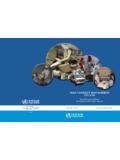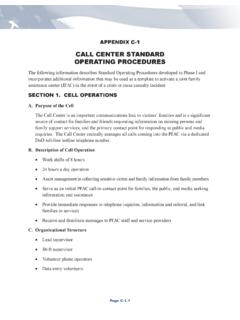Transcription of Disaster Risk Management for Health Fact Sheets Disaster ...
1 Disaster Risk Management for Health Fact Sheets Key Points Global Platform - May 2011 Disaster Risk Management for Health mass casualty Management Disasters from natural, technological and societal hazards lead to large numbers of non-fatal casualties or survivors. mass casualty Management is the Health sectors immediate priority in an emergency. Many deaths following natural disas-ters are preventable with rapid medical care. The medical response to a mass casualty event operates at two broad locations: on-site and at the hospital. Defined pre-hospital search and res-cue and triage are essential to determine patient treatment and transport priorities to save lives and optimise resources. A standardized and well rehearsed incident Management system to-gether with Standard Operating Procedures are paramount for linking site operations to Health -facility based care during an actual Disaster . Key Points PitWhy is this important?
2 In the last decade more than billion people have become casualties of natural Acute events such as earthquakes, landslides and cyclones, and rising tide events such as heat waves, floods or severe cold weather can result in significant numbers of casu-alties. An estimated million people are killed and as many as 50 million are injured each year in road crashes, of which a large number are mass casualty incidents. Projections indicate that these figures will increase by about 65% over the next 20 years. 2 Conflict and civil unrest may also result in many trauma cases. mass casualties following disasters and major incidents are often characterized by a quantity, severity, and diversity of injuries and other patients that can rapidly overwhelm the ability of local medical resources to deliver comprehensive and definitive medical care.
3 Casualties associated with natural disasters, particu-larly rapid-onset disasters, are overwhelmingly due to: blunt trauma. crush-related injuries. Drowning. mental Health issues. Most people affected by natural disasters DO NOT DIE and many deaths and long term consequences for casualties are preventable with timely and appropriate intervention. Casualties in temporary hospital, Mianzhu City, Sichuan Earthquake, 2008, WHO Example: Haiti earthquake (2010) The Haiti earthquake created 300,000 non-fatal casualties. Typically, approximately 60% of per-sons presenting to field hospitals require surgical intervention, of which 80% involved de-bridement of wounds and dressings with very few primary closures or external fixation Developed by the World Health Organization, United Kingdom Health Protection Agency and partners Further information, contact: WHO - Jonathan Abrahams (e-mail: Developed by the World Health Organization, United Kingdom Health Protection Agency and partners What are the Health risks ?)
4 Immediately after impact, severe trauma and wounds are the most urgent priority for medical Management . Maternal and new born emergency care as well as mental Health effects are other facets of these dra-matic situations. In these settings, trauma is often related to collapsing infrastructure and transport-related injury, though vio-lence and civil unrest can also be a follow-on cause of trauma. In flooding and tsunami, drowning is a major cause of death. Following the Gujarat earthquake in 2001, the most commonly injured areas were: lower extremity (56%). spinal and pelvic (17%). upper extremity (13%). chest and/or abdomen (<4%). crush syndrome (<2%). Early interventions are critical for survival and reduced Health impacts. Many casualties can be treated both on an outpatient or surgical basis. It is vital that care begin at the site, during search and rescue, which is nowadays more and more medi-calised.
5 First aid and essential surgical care capacities at local level can help to reduce trauma mortality in the short term and long-term morbidity and sequelae, including disabilities. Enhancing early warning systems and a re-sponsive community. Community first aid and search and rescue which the first line of the community response to mass casualty events. A standardized and well rehearsed incident Management system. Strengthening pre-hospital and hospital sys-tems to ensure the best outcomes for those severely injured in an , 5 Essential surgery and emergency care capacity at a local level can ensure that injured patients receive immediate life-saving treatment. Maternal and new born emergency care. Provision of psychosocial support for the af-fected community, and Management of mental Health effects. Maintenance of good communication to mini-mize disruptions to response and social support measures, prevent further injury, and maximize effective response outcome.
6 Rapid and timely deployment of trained per-sonnel to needed areas. Follow up treatment for recovery and rehabilita-tion, including equipment and devices for people with disabilities. References and further reading 1. World Bank (2005). Hazards of Nature, risks to Devel-opment. 2. WHO. World Health Report 2004 3. CDC. Post-Earthquake Injuries Treated at a Field Hospi-tal Haiti, 2010. MMWR 2011;59:1673-1677. 4. Disaster Management Guidelines WHO 5. WHO. mass casualty Management Systems: Strategies and guidelines for building Health sector Risk Management considerations Multisectoral action to reduce the risk of mass casualty situations include: Safe construction and maintenance of hous-ing, Health facilities and other buildings, and road safety measures. Public risk communication to promote personal and organizational safe behaviours, including responding to warnings, safe evacuations, shelter plans and protection from extreme events earthquakes, floods, tsunami.
7 Maintaining civil order reduce injuries and trauma that arise from inter-personal violence, escalating to conflict in the extreme. Local response and infrastructure Management can help reduce mortality and morbidity in the initial post impact period through: Identification, assessment and monitoring dis-aster risks related to trauma and overall mass casualty Management .














